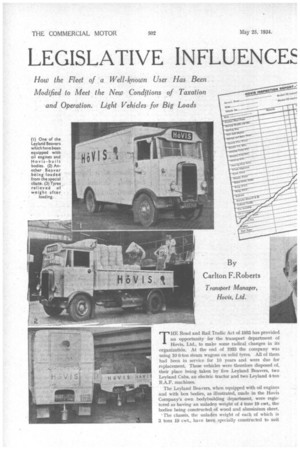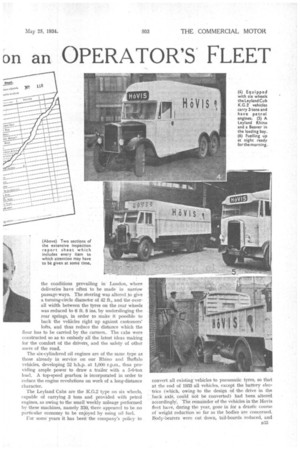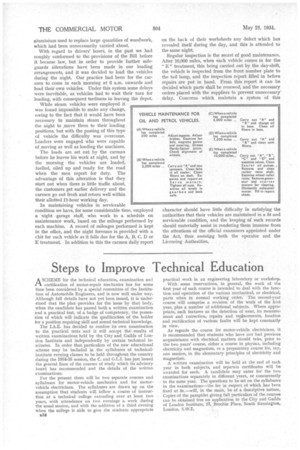LEGISLATIVE INFLUENCE
Page 50

Page 51

Page 52

If you've noticed an error in this article please click here to report it so we can fix it.
on an OPERATOR'S FLEET THE Road and Rail Traffic Act of 1933 has provided an opportunity for the transport department of Hovis, Ltd., to make some radical changes in its organizatidn. At the end of 1933 the company was using 10 0-ton steam wagons on solid tyres. All of them had been in service for 10 years and were due for replacement. These vehicles were therefore disposed of, their place being taken by five Leyland Beavers, two Leyland Cubs, an electric tractor and two Leyland 4-ton• R.A.F. machines.
The Leyland Beavers, when equipped with oil engines and with box bodies, as illustrated, made in the Hovis Company's own bodybuilding department, were registered as having an unladen weight of 4 tons 10 cwt., the bodies being constructed_ of wood and aluminium sheet. The chassis, the unladen weight of each of which is 3 tons 19 cwt., have been specially constructed to suit the conditions prevailing in London, where deliveries have often to be made in narrow passage-ways. The steering was altered to give a turning-circle diameter of 42 ft., and the over all width between the tyres on the rear wheels was reduced to 6 ft. 8 ins, by tmderslinging•the rear springs, in order to make it possible to back the vehicles right up against customers' lofts, and thus reduce the distance which the flour has to be carried by the carmen. The cabs were constructed so as to embody all the latest ideas making
tor the comfort of the drivers, and the safety of other users of the road.
The six-cylindered oil engines are of the same type as those already in service on our Rhino and Buffalo
vehicles, developing 52 b.1-Lp. at 1,000 r.p.m., thus providing ample power to draw a trailer with a 5-6-ton load. A. top-speed gearbox is incorporated in order to
reduce the engine revolutions on work of a long-distance character.
The Leyland Cubs are the .IC.G.2 type on six wheels, capable of carrying 3 tons and provided with petrol engines, as owing to the small weekly mileage performed by these machines, namely 350, there appeared to be no particular economy to be enjoyed by using oil fuel. For some years it has been the company's policy to aluminium used to replace large quantities of woodwork, which had been unnecessarily carried about.
With regard to drivers' hours, in the past we had roughly conformed to the provisions of the Bill before it became law, but in order to provide further safeguards alterations have been made in our loading arrangements, and it was decided to load the vehicles during the night. Our practice had been for the carmen to come in each morning at 6 a.m. onwards and load their own vehicles. Under this system some delays were inevitable, as vehicles had to wait their turn for loading, with consequent tardiness in leaving the depot.
While steam vehicles were employed it was found impossible to make any change, owing to the fact that it would have been necessary to maintain steam throughout the night to ,move them to their loading positions, but with the passing of this type of vehicle the difficulty was overcome. Loaders were engaged who were capable of moving as well as loading the machines.
The loads are set out by the carman before he leaves his work at night, and by the morning the vehicles are loaded, fuelled, oiled up and ready for the road when the men report for duty. The advantage of this alteration is that they start out when there is little traffic about, the customers get earlier delivery and the carmen go out fresh and return well within their allotted 11-hour working day.
In maintaining vehicles in serviceable condition we have, for some considerable time, employed a night garage staff, who work to a schedule on maintenance work, based on the mileage performed by each machine. A record of mileages performed is kept in the office, and the night foreman is provided with a chit for each vehicle as it falls due for the A, B, C, D or E treatment. In addition to this the carmen daily report
(A)Whenavehicle (B) When a vehicle has completed 2,500 miles ..
on the back of their worksheets any defect which has revealed itself during the day, and this is attended to the same night.
Regular inspection is the secret of good maintenance. After 10,000 miles, when each vehicle comes in for the "
E" treatment, this being carried out by the day-shift, the vehicle is inspected from the front number plate to the tail lamp, and the inspection report filled in before repairs are put in hand. From this report it can be decided which parts shall be renewed, and the necessary orders placed with the suppliers to prevent unnecessary' delay. Concerns which maintain a system of this character should have little difficulty in satisfying the authorities that their vehicles are maintained in a fit and serviceable condition, and the keeping of such records should materially assist in rendering them immune from the attentions of the official examiners appointed under the Act, thus assist*g both the operator and the Licensing Authorities.




































































































